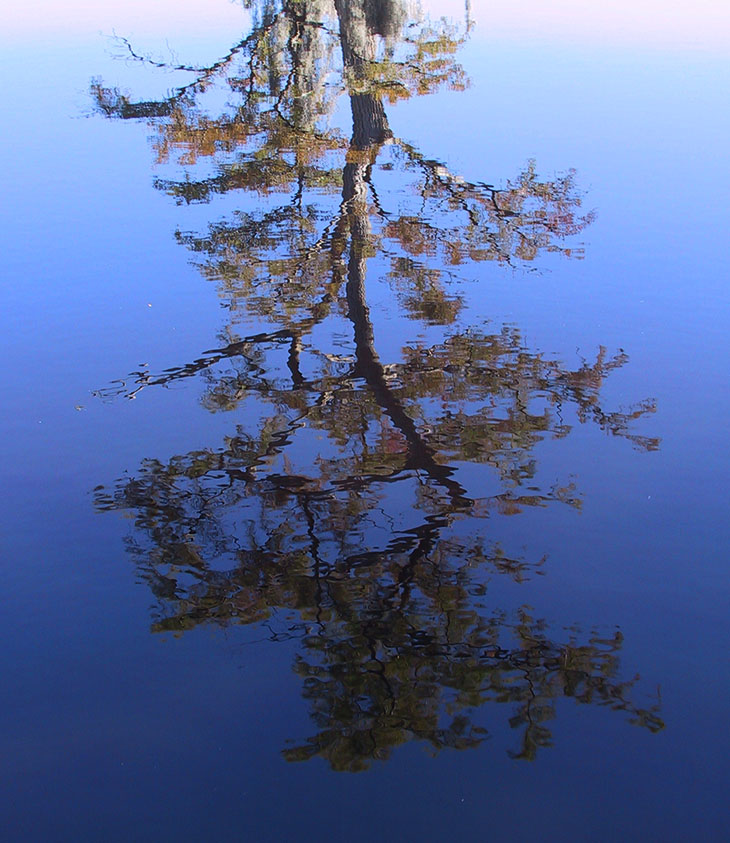While it may seem that “water” is more of a subject than a compositional tool or element, there are actually so many ways to use it that it begs for greater examination. So let’s dive in sorry – sometimes you can’t resist.
 The primary trait is, of course, reflectivity. It can mirror a subject on a lakeshore or provide a duplicate sky behind a subject without having to be aiming upwards. Drops can give sparkles of sunlight even off of the tiniest of subjects. It can even provide cool double-exposure effects when the reflection still allows some transparency to reveal what lies beneath. Too often, we’re so used to it that we tune it out as simply water, and fail to see the colors or images it can provide in a photo. Most especially, we often don’t realize that changing our viewing angle can produce radically different results.
The primary trait is, of course, reflectivity. It can mirror a subject on a lakeshore or provide a duplicate sky behind a subject without having to be aiming upwards. Drops can give sparkles of sunlight even off of the tiniest of subjects. It can even provide cool double-exposure effects when the reflection still allows some transparency to reveal what lies beneath. Too often, we’re so used to it that we tune it out as simply water, and fail to see the colors or images it can provide in a photo. Most especially, we often don’t realize that changing our viewing angle can produce radically different results.
Then there are the textures. Waves and ripples, drops and mist, often reflecting from multiple angles to show the invisible sky or nearby foliage. The camera can halt the movement of water and create a curious surreal effect; alternately a long shutter speed can let the motion blur into a soft cloudy haze, as in the more common waterfall images.
And we cannot forget the ideas it communicates. Wet surfaces and drops may tell us of recent rains, while dew says, “morning” – the difference between these can be nothing more than semi-overcast lighting versus bright sunlight. The curl of an ocean wave is remarkably evocative, and artistic in itself, but it’s an entirely different message from the glassy surface of a motionless lake. A single drop in the right location can be a focal point or tell a story, and when it turns to ice/snow/frost, it gains a whole new set of connotations.
So, some ideas on using it:
Angle – Reflections and even transparency will change depending on what angle you view the surface, and of course, small changes in position can change what’s being reflected by it, giving a splash of color to offset a subject or reducing the background distractions by reflecting the shadowy foliage. Spotlight reflections from the sun can be placed where needed or avoided entirely.
Texture – Very small ripples provide smooth gradients and less variation in reflections, allowing for a predominant color as desired. High winds and rough water often produce contrasty textures, nearly black and white. When using fast shutter speeds to freeze the action, take several exposures since you never know just what’s been captured. Very long exposures under muted, indirect light like overcast skies or shade (or moonlight!) will produce softer textures as these changes blur together, while doing so in bright sunlight will produce lots of spots and streaks from the momentary sparkles.
Dew – This disappears rapidly under bright sunlight, so seeking images either before full sunrise or in areas of deeper shade provides more time to work. However, sunlight on dew is also a cool effect sometimes – it just means you have to move fast because you may have less than a minute, depending on conditions, to get the shot. Be early, and be ready.
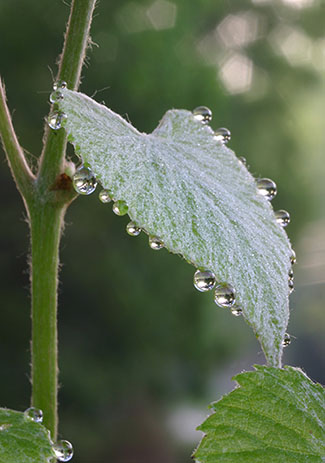 Because dew and raindrops display their surroundings in a semi-globular manner, their affect and appearance often depend on what’s in the roughly 140° spherical arc behind them. Often, this means bright sky and dark foliage, but it may also mean certain dominant colors. Keep this in mind, because shooting angle can change this significantly, and you may find that the scene benefits from contrasty drops, or gets a hint of color from a nearby flower that’s not actually in the frame.
Because dew and raindrops display their surroundings in a semi-globular manner, their affect and appearance often depend on what’s in the roughly 140° spherical arc behind them. Often, this means bright sky and dark foliage, but it may also mean certain dominant colors. Keep this in mind, because shooting angle can change this significantly, and you may find that the scene benefits from contrasty drops, or gets a hint of color from a nearby flower that’s not actually in the frame.
Exposure metering and flash – Water can be tricky. A strong reflection of sunlight in the wrong area of the viewfinder can skew the exposure reading way off the mark. When you see sparkles in the viewfinder, get several meter readings and watch for out the one that is drastically different from the others (a much faster shutter speed or significantly smaller aperture) – that’s the one that got blinded by the light and you don’t want to use. Also, the camera flash can be bounced back into the lens by either a direct angle or significant ripples, and this includes any exposure preflash that your camera may use too, wrecking your exposure reading. Then there’s the simple trait that a wet surface darkens almost any subject, so exposure readings can go in the opposite direction too, trying to bring that darkness back up to the middle tone that camera meters are calibrated for.
Also note here that the wind picking up can alter your exposure reading, by causing a water surface that was mirror-like to break into multiple shapes reflecting sky, sun, or surrounding foliage.
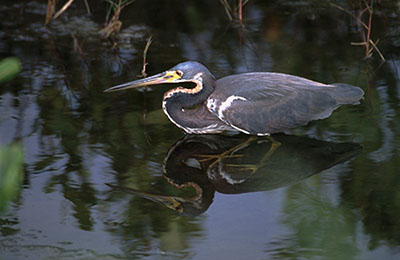 Reflections – Two things of note here. The first is that reflections in water are always darker than the original, so the sky’s colors will be deeper in the lake surface; plan accordingly (if, for instance, you’ve gotten an exposure reading from the surface, and the actual sky is included in the frame too, the sky is likely to go too bright.) Also be aware that focal distance of something reflected in the surface is not to the surface itself, but bouncing off of it all the way to the subject. Focusing on the moon reflected in the surface, as well as rocks or plants alongside, will require a very high depth-of-field and is likely to fall outside the range that can be achieved.
Reflections – Two things of note here. The first is that reflections in water are always darker than the original, so the sky’s colors will be deeper in the lake surface; plan accordingly (if, for instance, you’ve gotten an exposure reading from the surface, and the actual sky is included in the frame too, the sky is likely to go too bright.) Also be aware that focal distance of something reflected in the surface is not to the surface itself, but bouncing off of it all the way to the subject. Focusing on the moon reflected in the surface, as well as rocks or plants alongside, will require a very high depth-of-field and is likely to fall outside the range that can be achieved.
Contrast – Because of both the darkening effect and the increased reflections, as noted above, wet surfaces increase contrast. This can make some colors richer, but it can also produce too much contrast in certain conditions. The nice thing about shooting on rainy days is the overcast provides light that helps control this, but wet surfaces under full sunlight can become very harsh.
Penetration – Shooting subjects that are under water, from above the surface, can sometimes be tricky. Bright sunlight penetrates best, but of course throws those starburst reflections that can get in the way. However, hazy to overcast skies make it nearly impossible to see beneath the surface, since the light coming from all directions means there’s no way to face that doesn’t produce reflections from the surface. A polarizing filter can help a lot, because light reflected from water is polarized and can be reduced or eliminated with such a filter, as long as it’s oriented properly. With just about all of today’s cameras, a circular polarizer is recommended. Another trick is using a shadow (your own does in a pinch) to block the sky from the surface you’re attempting to shoot through, though this does reduce light on your subject as well, and shutter speed may become an issue. Also, be aware that a rippling surface will almost certainly distort everything beneath – we tend to average this out in our minds and ignore the distortion, but the camera will capture one moment and the funhouse mirror effect it produces.
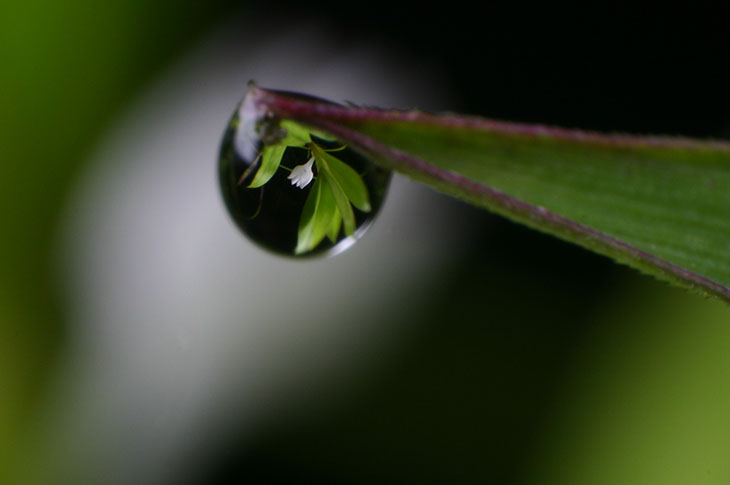
Water drops as lenses – This effect, becoming more popular now, is very cool but very demanding. A nice round water drop will act as an inverting lens for subjects behind it, creating a reproduction of the background upside-down and in miniature – very miniature. A macro lens is necessary, and you’re not focusing on the water surface but the apparent distance the drop lens produces – this means the edges of the drop might actually be out of focus while the image within is sharp. And of course, while using a flash (and you should,) the flash needs to be aimed at the background subject and not the drop, which might produce starburst reflections that obscure your subject.
Fog – You don’t need me to tell you how cool fog is. But what I can say is a) fog at night is especially fun to play with, and a few bright lights in the frame will significantly enhance the effect, and b) try to have some nearby areas in mind that would look great in fog, so you know where to go when the conditions strike – this will likely be different between day and night shots. Don’t use flash on or near the camera, because it will bounce from the individual mist droplets and bespeckle your image. Unless you’re selling ‘ghost’ pics to the gullible…
Because of the muted light, you’re likely to want a tripod even for the day shots, especially since fog mostly occurs in early morning. A heavy fog will give you mist drops on surfaces to work with too.
Underwater – This is a highly specialized field, one that I admit I cannot help you with very much. My experience comes from using small, specialized aquariums to photograph aquatic subjects, which is a much more accessible way of doing it than having elaborate underwater camera rigs and diving gear. Some of the same traits apply, however: you will almost always need to be using extra lighting, and at an off angle – this reduces reflections from both suspended sediment and aquarium rear surfaces. Contrast is reduced. The underside of the surface of the water is a brilliant mirror when you can use it. And air bubbles are even more distinct that water drops in their reflectivity. But while we’re here…
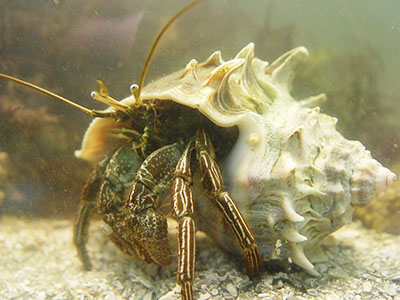
I doubt you could avoid water in your images even if you tried, but hopefully, this provides a few ideas on using it as a strong element (Ha! Oh, the wit…)
Good luck!
